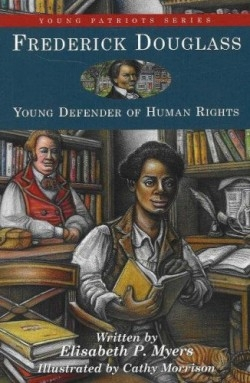Frederick Douglass
Young Defender of Human Rights
- 2007 INDIES Finalist
- Finalist, Juvenile Fiction (Children's)
“Fred began to think more and more about the sadness of slavery…she [Mrs. Auld] started much of his misery. If she hadn’t begun to teach him how to read, he wouldn’t know what he was missing.” So begins the activism of Frederick Bailey, known to us as Frederick Douglass, the great abolitionist. Before he knew how to read, he was the faithful slave to the Auld family, moving from the plantation in Maryland to Hugh Auld’s family home in Baltimore where he served as caretaker to their young son, Thomas.
For the first five years of his life, Frederick Bailey was comfortable, but when he was moved to the work farm, his life began to change. He was now witness to the whippings and mistreatment of older slaves and even took part in a revolt against a particularly brutal Master. Fortunately for Frederick, Miss Lucretia, the Master’s daughter, felt sorry for him and made him her slave. After a time, he was sent to help her brother-in-law in Baltimore, Hugh Auld, with his son. In Baltimore, Frederick began to dream of freedom. He learned to read, and he even broke the law and purchased (with labor) a book called The Columbian Orator where he read the words of great freedom fighters such as Patrick Henry. With the death of Miss Lucretia, Frederick was moved from Master to Master, and his desire for freedom only grew. In 1838, he ran away to New York, and after several hard years, married and was drawn in by the abolitionists who believed that Frederick would be the perfect orator for their cause.
This book is part of the Young Patriots series, and it details a part of the famous abolitionists life that isn’t often discussed in other biographies of him. Readers learn about the events that took place during his childhood that molded him into the activist that he became, and children will get a clearer picture of the man through the stories of his youth. The author is well-versed in biographies for young people; she has published twenty-one so far, including Langston Hughes and Mary Cassatt. She clearly appreciates her audience, while trying to give them a good historical foundation. Also included in the book is a brief report of what happened next to Douglass, interesting facts about him, a timeline of other events that occurred during his life and a glossary.
This readable, interesting book will give young people an accessible look at another aspect of a man they study often throughout their school careers. And perhaps it will show the power of reading as well.
Disclosure: This article is not an endorsement, but a review. The publisher of this book provided free copies of the book to have their book reviewed by a professional reviewer. No fee was paid by the publisher for this review. Foreword Reviews only recommends books that we love. Foreword Magazine, Inc. is disclosing this in accordance with the Federal Trade Commission’s 16 CFR, Part 255.

